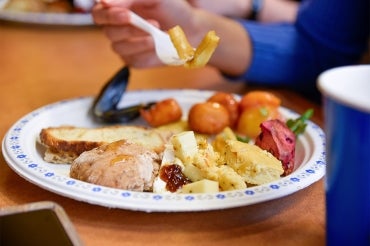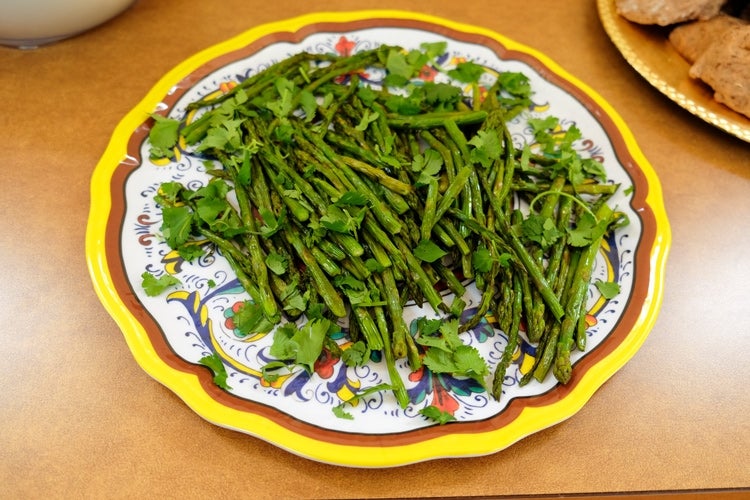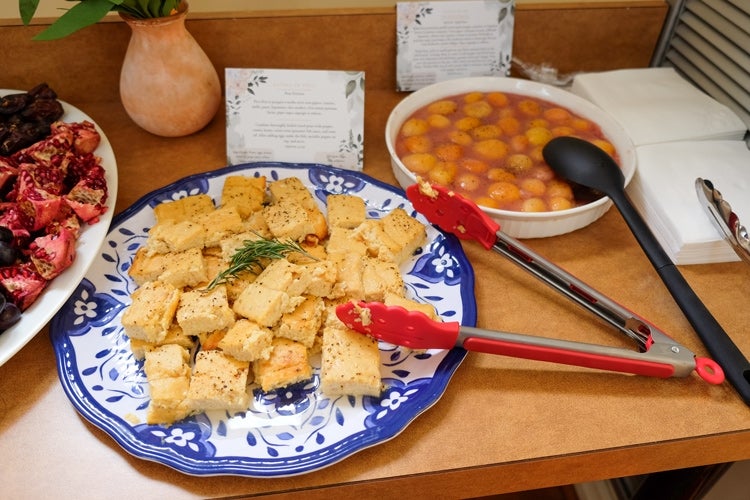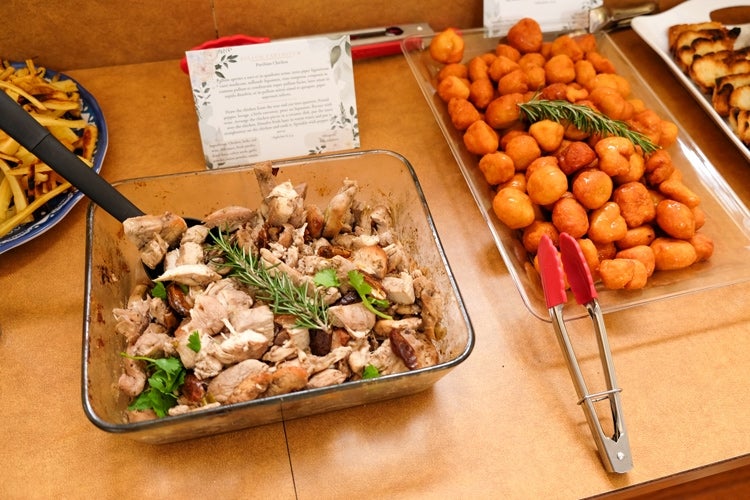Classics students whip up a taste of ancient history

Students and professors ate some of the same foods ancient Greeks and Romans served at dinners thousands of years ago (photo by Teodora Mladin)
Published: January 30, 2024
It was a feast fit for the gods.
Professors, graduate and undergraduate students enjoyed some of the same foods ancient Greeks and Romans served at dinners thousands of years ago at Ancient Food Day, organized by the Classics Students’ Union.
“Ancient Food Day is more than just a culinary festivity,” says Teodora Mladin, president of the student union and a sixth-year student with a double major in classical civilizations and French linguistics who is a member of Trinity College.
“Food is one of the primary ways we share and retain our cultures. So, by indulging in these recipes, we momentarily taste the traditions, stories and experiences of ancient peoples.”

Tasting those traditions included enjoying dishes such as: “Parthian chicken,” cooked with leeks, red wine, dried dates, garlic and cumin; and parsnip fries, cooked with olive oil, honey, apple cider vinegar, cornstarch, celery seed, rosemary, pepper and fish sauce. The event’s organizers said the dishes were very popular in 224 CE.
A plate of asparagus, meanwhile, was prepared with marjoram, which, students said, tastes like smoked fish when mixed with coriander.
There were also plenty of choices for those with a sweet tooth such as enkrides – the ancient equivalent to Timbits. These fried cheese dough balls are cooked in olive oil and then covered in honey. Or there was melitoutta, which are honey cakes that resemble scones. Apparently, this was a dessert deceased souls would bring to the underworld.

Attendees also enjoyed “pear patina,” frittatas made with boiled cored pears and prepared with eggs, honey, olive oil, grape juice and white wine, offering both savoury and sweet flavours.
The dishes were washed down with beverages such as “Nectar of the Gods” – a mango-nectar-based drink and a mulled pomegranate drink called “Persephone in the Underworld.” Inspired by the myth of Persephone’s abduction by Hades, its Greek description translates to “fire burning at night,” referring to its spiced quality as well as its dark, glittery colour.
The event was the culmination of weeks of preparation that included searching for original recipes, translating them and then preparing dishes as true to the originals as possible. The group also created placards for each dish that contained the original Greek recipe, the English translation and fun facts.

Izzy Friesen, a fourth-year classics and classical civilizations student, says translating recipes was an enriching experience from both a language and history perspective.
"Getting to translate recipes allowed me to engage with Latin in a different way,” says Friesen, a member of Victoria College. “It was particularly valuable for us to attempt our own translations and look for recipes that caught our eye. It’s useful and exciting for language-learners but not necessarily something we’d get to do in the classroom."
Madeleine Andrasic, a second-year student with a double major in classical languages and history, and a member of University College, also found translating the recipes to be rewarding.
“It really becomes evident that Greeks and Romans saw food in both similar and different ways to us,” says Andrasic. “So much cultural and environmental history can be revealed in these texts, [sparking] further questions about food availability and food preferences in the ancient world."

For Tessa Delaney-Girotti, a fourth-year student with a double major in classical civilizations and archeology, preparing the dishes strengthened her connection to ancient peoples.
“It’s not only a unique experience to be able to eat the same kind of food as someone from thousands of years ago, but there’s also something about cooking those recipes, putting yourself into their shoes, that brings to mind the everyday activities of their lives,” says Delaney-Girotti, a member of University College who is vice-president of the student union.
“Most of the time we feel far removed from the people we read about, but this brings a whole new perspective.”

Mladin, too, says gathering to share a meal is a timeless human experience and organizing and hosting Ancient Food Day further connected her to the cultures she’s studying.
She added that the Classics Students' Union has seen so much interest in the recipes that it intends to create an ancient recipe blog.
“The dishes we present are an emblem of history, a testament to the cultural exchanges, advancements and the ever-evolving human story,” she says. “We are reminded of the depth and breadth of the ancient civilizations that shaped the very focus of our department."

